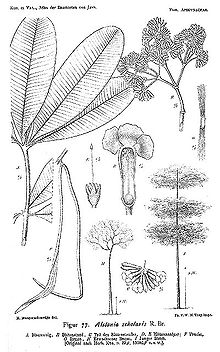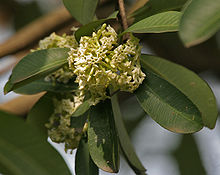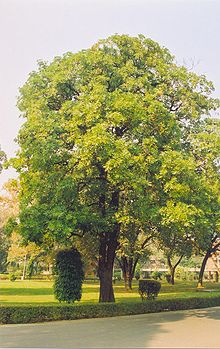- Alstonia scholaris
-
Alstonia scholaris 
Indian Devil tree (Alstonia scholaris) Conservation status Scientific classification Kingdom: Plantae (unranked): Angiosperms (unranked): Eudicots (unranked): Asterids Order: Gentianales Family: Apocynaceae Tribe: Plumeriae Subtribe: Alstoniinae Genus: Alstonia Species: A. scholaris Binomial name Alstonia scholaris
L. R. Br.Alstonia scholaris (Apocynaceae, commonly called Blackboard tree, Indian devil tree, Ditabark, Milkwood pine, White cheesewood and Pulai; syn. Echites scholaris L. Mant., Pala scholaris L. Roberty) is an evergreen, tropical tree native to the Indian subcontinent and Southeast Asia.
Contents
Description
Alstonia scholaris is a small tree that grows up to 40 m tall and is glabrous. The bark is greyish; branchlets are copiously lenticellate.
The upperside of the leaves are glossy, while the underside is greyish.[1] Leaves occur in whorls of 3-10; petioles are 1–3 cm; the leathery leaves are narrowly obovate to very narrowly spathulate, base cuneate, apex usually rounded; lateral veins occur in 25-50 pairs, at 80-90° to midvein. Cymes are dense and pubescent; peduncle is 4–7 cm long. Pedicels are usually as long as or shorter than calyx. The corolla is white and tube-like, 6–10 mm; lobes are broadly ovate or broadly obovate, 2-4.5 mm, overlapping to the left. The ovaries are distinct and pubescent. The follicles are distinct and linear.
flowers of Alstonia blooms in the month October. The flowers are very fragrant similar to the flower of Cestrum nocturnum.
Seeds of A. scholaris are oblong, with ciliated margins, and ends with tufts of hairs 1.5–2 cm.[2] The bark is almost odourless and very bitter, with abundant bitter and milky sap.
Range
Alstonia scholaris is native to the following regions[3]:
- China: Guangxi (s.w.), Yunnan (s.)
- Indian subcontinent: India; Nepal; Sri Lanka; Pakistan
- Southeast Asia: Cambodia; Myanmar; Thailand; Vietnam, Indonesia; Malaysia; Papua New Guinea; Philippines
- Australia: Queensland
It has also been naturalised in several other tropical and subtropical climates. Alstonia scholaris (Saptaparni in Bengali) is declared as the State Tree of West Bengal, India
Uses
Alstonia or devil tree or Saptaparni is genus of evergreen trees or shrubs with white funnel-shaped flowers and milky sap. In India the bark of Alstonia scholaris is used solely for medicinal purposes, ranging from Malaria and epilepsy to skin conditions and asthma.
in Ayurveda it is used as a bitter and as an astringent herb for treating skin disorders, malarial fever, urticaria, chronic dysentery, diarrhea, in snake bite and for upper purification process of Panchakarma . The Milky juice of the tree is applied to ulcers. Source: http://www.india-shopping.net/india-ayurveda-products/Alstonia-saptaparni.htm (Please Note: i am not advertising this website)
The bark contains the alkaloids ditamine, echitenine and echitamine and used to serve as an alternative to quinine. At one time, a decoction of the bark was used to treat diarrhoea and malaria, as a tonic, febrifuge, emmenagogue, anticholeric and vulnerary. A decoction of the leaves were used for beriberi.[1] Ayurveda recommends A. scholaris for bowel complaints. In Sri Lanka its light wood is used for coffins. In Borneo the wood close to the root is very light and of white colour, and is used for net floats, household utensils, trenchers, corks, etc.[4] Extracts prepared from the plant has been reported to possess cytotoxic activity. The active compounds include alkaloids, flavonoids etc. These are present in all parts of the plant. An ethanol extract of the bark of Alstonia scholaris enhanced the anticancer activity of berberine in the Ehrlich ascites carcinoma-bearing mice. This extract also showed cytotoxic activity to HeLa cells.[5][6] It contains echitamine and loganin as major compounds and could potentially be used as an anti-irritation agent. [7]
References
- ^ a b http://www.stuartxchange.org/Dita.html retrieved on 29 June 2007
- ^ http://www.efloras.org/florataxon.aspx?flora_id=2&taxon_id=200018323 retrieved on 29 June 2007
- ^ http://www.ars-grin.gov/cgi-bin/npgs/html/taxon.pl?2688 retrieved on 29 June 2007
- ^ http://www.botanical.com/botanical/mgmh/a/alsto028.html retrieved on 29 June 2007
- ^ http://sciipub.com/index.php/forum/2-international-journal-of-pharmacology-a-toxicology-science-issn-2249-4502/77-in-vitro-cytotoxicity-assay-of-alstonia-scholaris-misra-chandra-shekhar-pratyush-kumar-james-joel-sagadevan-lipin-dev-mundur-veettil-arun-kumar-thaliyil-v-thankamani
- ^ http://www.ncbi.nlm.nih.gov/pubmed/15298773
- ^ http://www.ncbi.nlm.nih.gov/pmc/articles/PMC3170789/?tool=pmcentrez
-
- USDA, ARS, National Genetic Resources Program. Germplasm Resources Information Network (GRIN) Online Database. National Germplasm Resources Laboratory, Beltsville, Maryland; source url: http://www.ars-grin.gov/cgi-bin/npgs/html/taxon.pl?2688 retrieved on 29 June 2007
Categories:- IUCN Red List least concern species
- Alstonia
- Flora of Nepal
- Flora of Sri Lanka
- Flora of Cambodia
- Flora of Burma
- Trees of Thailand
- Flora of Vietnam
- Flora of Indonesia
- Flora of Malaysia
- Trees of Papua New Guinea
- Trees of the Philippines
- Flora of Queensland
- Trees of China
- Flora of Pakistan
- Trees of India
- Gentianales of Australia
- Trees of Australia
- Least concern flora of Australia
- Least concern biota of Queensland
Wikimedia Foundation. 2010.




